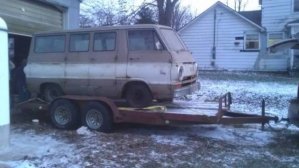I just picked up a 1965 A-100 Window van that has been parked for 34 years (inside and on cement) and I am wishing to simply make it a daily driver/Home Depot runner/pull a small trailer utility vehicle. It is a /6 with three on the tree with 30+ years of maintenance to catch up on.
The thing I am curious about are...
1: Any good build threads of A-100's I could read through and get ideas from?
2: Any good suppliers that carry an abundance of parts for these or are they going to be scattered like I think they will be?
3: Pop out window surround frames? The metal frames around my pop out windows are rusted out and barely holding the glass in. Has anyone come up with something they made work for these? I am not against making something else work. Glass is great, metal is shot.
4: Good sheet metal source? Front of front wheel rockers, floor boards near wheel houses, left upper shock mount GONE...
5: Dakota independent suspension transplant thread???
I am sure I will have more but this will get me goin.


The thing I am curious about are...
1: Any good build threads of A-100's I could read through and get ideas from?
2: Any good suppliers that carry an abundance of parts for these or are they going to be scattered like I think they will be?
3: Pop out window surround frames? The metal frames around my pop out windows are rusted out and barely holding the glass in. Has anyone come up with something they made work for these? I am not against making something else work. Glass is great, metal is shot.
4: Good sheet metal source? Front of front wheel rockers, floor boards near wheel houses, left upper shock mount GONE...
5: Dakota independent suspension transplant thread???
I am sure I will have more but this will get me goin.


